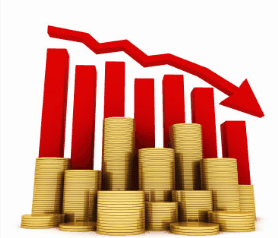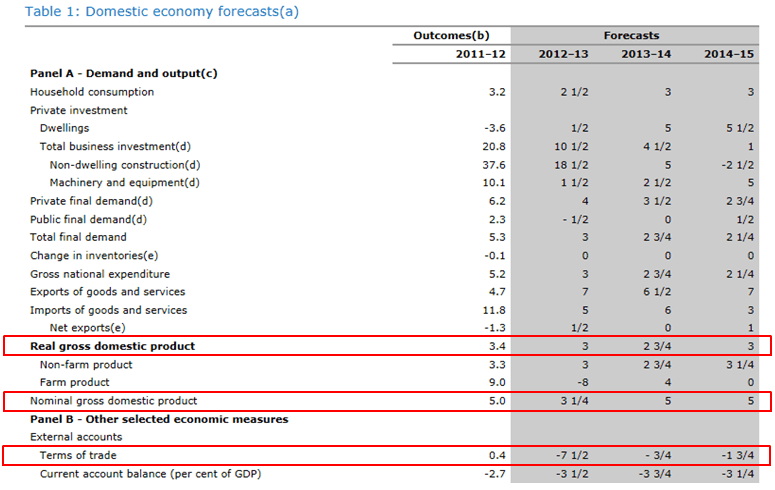
The Australian newspaper today contains some interesting discussion on the state of Federal Government budget finances, which it argues are likely to remain in deficit for a prolonged period of time following reckless tax and spending decisions undertaken by both the formal Howard Government and the current Labor Government, which has left the budget in structural deficit:
Ringing the alarm on fiscal policy barely one week after the federal budget, two independent reports from the Parliamentary Budget Office and the federal Treasury reveal a sharp decline in the structure of the budget that will last for most of the decade…
The simultaneous studies, which were released yesterday in an apparent coincidence, show that the deficit in 2016-17, when the government is promising a $6.7bn surplus, would be between $5bn and $22bn that year, were it not for the Treasury’s assumption that commodity prices would only fall very gradually.
Deloitte Access Economics director Chris Richardson said the average estimate of a $16bn deficit in 2016-17 was a “stunning difference” from the official forecast.
“This shows there is a coal and iron ore bubble that has made the Australian budget numbers look much better than they really are,” Mr Richardson said…
The PBO blamed the generous tax cuts over the past decade for helping to drive the budget into a structural deficit… It found that personal income tax cuts put in place since 2003 were responsible for two-thirds of the decline in structural tax receipts over the past decade.
In a seperate Australian article, David Uren questions whether the Treasury’s assumptions around China’s economic growth and urbanisation are correct, which Treasury believes will result in only a modest slide in the commodity prices and the terms-of-trade, allowing the Budget to return to surplus sooner:
The pivotal issue is Treasury’s understanding of the resource sector… Treasury concluded that the rise of China would bring decades of prosperity to our shores.
Although the shortages that sent commodity prices to stratospheric levels would ease as new mines were commissioned, prices for Australia’s exports would remain permanently higher.
Charts of previous resource booms have looked like the Eiffel Tower, with prices tumbling back to where they started from just as fast as they rose.
But Treasury believes the continued urbanisation of China will keep Australia’s main exports in short supply, with only modest declines in coming years. Parkinson estimates there will be a 20 per cent fall in Australia’s export prices across the next 15 years, but they still will be about 50 per cent above their long-term averages…
A rival outlook to the one Treasury presents is that China’s growth will slow by more than expected, and the metal intensity of its growth will slow more rapidly as the government reins in the massive infrastructure and property development of the past decade. If Treasury is wrong about China and demand for our resources, it will be wrong about everything else in the budget.
Uren’s scepticism is well founded. As argued in my post Budget report, Treasury’s terms-of-trade and nominal GDP forecasts – critical drivers of budget revenues – appear highly optimistic (see below table).

As noted in that post, the terms of trade forecasts are particularly aggressive. They assume significant uplift for the March and June quarters for this year, an almost non-existent fall next year and only a -2% fall in 2014-15. In our view, these figures do not come terms with a China’s slowing economy and rebalancing away from investment-led growth, or the large increase in commodity supply due to come on-line globally. Readers seeking a good understanding of these issues are encouraged to re-visit MacroBusiness’ interview with Professor Ross Garnaut earlier in the week.
As a result of the benign terms-of-trade outlook, Treasury’s nominal GDP forecasts are similarly bullish. Nominal GDP grew by just 2.0% in the year to December 2012, yet the Treasury has forecast that it will miraculously rebound to 3.25% in 2012-13 and to 5% in both 2013-14 and 2014-15. Moreover, nominal GDP is expected to rise to levels that are well above real GDP throughout the forecast period, from -1.1% below real GDP in the year to December 2012.
According to the Budget papers, a 1% change in the value of goods and services generates a $2.8 billion shift in the budget bottom line in the first year and a $7 billion shift in the second. Therefore, by assuming stronger growth in nominal GDP, the Treasury has likely overestimated Budget revenues and the path back to surplus.
However, the budget is facing pressures beyond just falling commodity prices (terms-of-trade). As explained early last week, mining-related capital expenditures (capex), which make-up around 7% of Australia’s GDP currently, are shortly expected to decline. The Bureau of Resources and Energy Economics (BREE) yesterday forecast a steepening decline, whereas Professor Garnaut believes that mining-related capex will fall back to 2% of GDP over the next few years.
According to the Reserve Bank of Australia (RBA), mining-related activities employ nearly 10% of the Australian economy, with around half of these workers employed in activities related to capex, such as engineers, construction workers, and ancillary services. Therefore, as mining capex declines, it will detract from Australia’s GDP growth and employment, again placing pressure on the Federal Budget via lower personal and company tax receipts and higher welfare payments.
To add insult to injury, Australia’s population is ageing rapidly as the baby boomers retire. The implications for the Federal Budget are two-fold. First, the Government will have a much smaller pool of workers with whom to collect taxes from, making it much more difficult for the Government to raise the required amount of tax revenue. Second, the higher proportion of retirees and older aged Australians will increase the amount of health and aged-care expenditure, significantly increasing overall Budget outlays.
In short, without radical reforms to the way taxes are collected and fiscal expenditures, the Federal Budget is facing a decade of deficits, irrespective of which party is in office.

